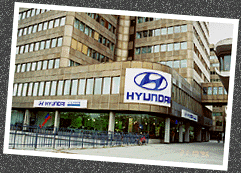
|
info@hyundai-at.si |
| ROSA BRUECKL, GREGOR SCHMOLL :B-W The History of Incorporated Moments - A Soulful Critique |


|
|
Five monitors, each showing a still from a different movie, form a row. The stills are not authentic, but staged mimetically by the artists themselves. Their “models“, taken from films like The Silence (Au Bout de Souffle), merely function as the starting point for an interpretation which does without spatial representation, preferring a plane background in order to focus solely on the actors’ body language. Even so there is only “action“ in the sense that they represent a snapshot of a scene, a significant memorable moment; they do not re-enact anything. In other words they reduce action to a relevant pose and keep it for a few minutes. They only reveal the intensity of the posing by their breathing bodies, blinks, and minute movements, and by their corrections. “Frozen moments” are prolonged and animated to tableaux vivants. In the coexistence and interplay of the various poses the stills liquefy and become a cinematic installation again. The extended moments curdle to the pasticcio of a fragmented narrative about the forms and formulas of relationships. This is where Rosa Brueckl and Gregor Schmoll’s reflections commence. The fact that the public as well as our own self-perception are strongly influenced and transformed by the media need no longer be put in the foreground. Hollywood and Co. deliver daily modified patterns of socialisation and identity as referents of our perception. The artists’ installation’s title, B-W (black and white) does not, lastly, remind us of the classical dialectics of Good and Evil, the hero and his victim. Passion and discord, longing and desire, boredom and distrust—these forms of experience are not only well-known to all of us, but also constitute the emotional rhetoric of cinematic networks of relationships. Where the profiles of our everyday experience, only very rarely able to express themselves purely, overlap with other marginal stories, cinema offers ideal patterns and parameters of behaviour in its darkroom, its camera angles and staged concentration. Moreover, these patterns not only explain our desire for the screen, but, simultaneously, function as a surrogate for our own emotional dilettantism. Yet instead of simply disavowing Hollywood and cinema as such, or merely unmasking their illusory character to replace them with a more adequate view of ourselves, Brueckl and Schmoll have developed a strategy of generating ambivalent self-portraits based on alienated patterns of identity , thus placing the subject in the space somewhere between media images and empirical reality. In this way the exaggeration of cinematic rhetoric is fused with the intensity of performance body language to plead for a hybrid aesthetic condition, a hybrid image of ourselves. Yet the suggestive and ideological moment of identification with the screen personalities does not only function as a projection and surrogate of an ideal reality: the mimetic interpretation of the relevant significant moments allows the artists to incorporate them via pictorial appropriation and hence even become these moments themselves. Here we are confronted with a paradox also contemporaneous in the films of Quentin Tarantino, who, incidentally, prefers to employ classical film genres too: our knowledge of the implied criticism of the rhetorical substance does not prevent us from enjoying ironically and none the less corporeally the experience of these clichés. Being doubled they are objectified, and their empirical essence is based on their intensification. The simulacrum, as already stated in Pierre Klossowski ´s pictures and texts, has learned how to walk. What is brought into discussion is no new media criticism, but a new evaluation and placing of criticism itself. Where criticism has so far been the vis-a-vis with the purer conscience, an antipode on a theoretical fundament, it is now being animated, even becoming corporeal, itself. Criticism is not the productive result of an oeuvre, but its starting point. Similarly criticism itself is open to aesthetic practice, and sometimes mediates itself highly entertainingly. Andreas Spiegl Translation O. L.
Vec informacij o korporaciji Hyundai pa lahko dobite na naslednjih naslovih:
|
|
|